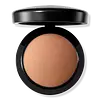Mac Cosmetics Mineralize Skinfinish Natural Face Powder Versus Makeup by Mario Softsculpt Blurring Bronzer
What's inside
What's inside
 Key Ingredients
Key Ingredients

 Benefits
Benefits

 Concerns
Concerns

 Ingredients Side-by-side
Ingredients Side-by-side

Mica
Cosmetic ColorantDimethicone
EmollientIsopropyl Palmitate
EmollientPolysorbate 20
EmulsifyingSimmondsia Chinensis Seed Oil
EmollientYeast Extract
Skin ConditioningTocopheryl Acetate
AntioxidantLauroyl Lysine
Skin ConditioningEthylhexyl Methoxycinnamate
UV AbsorberMagnesium Aluminum Silicate
AbsorbentSodium Dehydroacetate
PreservativePhenoxyethanol
PreservativeCI 77891
Cosmetic ColorantIron Oxides
CI 77163
Cosmetic ColorantCI 75470
Cosmetic ColorantCI 77288
Cosmetic ColorantCI 77289
Cosmetic ColorantCI 77510
Cosmetic ColorantCI 77742
Cosmetic ColorantCI 77007
Cosmetic ColorantCI 42090
Cosmetic ColorantCI 15850
Cosmetic ColorantCI 19140
Cosmetic ColorantCI 15985
Cosmetic ColorantMica, Dimethicone, Isopropyl Palmitate, Polysorbate 20, Simmondsia Chinensis Seed Oil, Yeast Extract, Tocopheryl Acetate, Lauroyl Lysine, Ethylhexyl Methoxycinnamate, Magnesium Aluminum Silicate, Sodium Dehydroacetate, Phenoxyethanol, CI 77891, Iron Oxides, CI 77163, CI 75470, CI 77288, CI 77289, CI 77510, CI 77742, CI 77007, CI 42090, CI 15850, CI 19140, CI 15985
Synthetic Fluorphlogopite
Mica
Cosmetic ColorantMagnesium Myristate
Lauroyl Lysine
Skin ConditioningDimethicone
EmollientCalcium Sodium Borosilicate
Silica
AbrasiveIsodecyl Neopentanoate
EmollientTrimethylsiloxysilicate
EmollientSodium Hyaluronate
HumectantPolypropylsilsesquioxane
Caprylyl Glycol
EmollientDiisostearyl Malate
EmollientDimethiconol
EmollientPhenoxyethanol
PreservativeHexylene Glycol
EmulsifyingCaprylic/Capric Triglyceride
MaskingPolyhydroxystearic Acid
EmulsifyingTriethoxycaprylylsilane
Isostearic Acid
CleansingLecithin
EmollientPolyglyceryl-3 Polyricinoleate
EmulsifyingCI 77491
Cosmetic ColorantCI 77492
Cosmetic ColorantCI 77499
Cosmetic ColorantCI 77742
Cosmetic ColorantSynthetic Fluorphlogopite, Mica, Magnesium Myristate, Lauroyl Lysine, Dimethicone, Calcium Sodium Borosilicate, Silica, Isodecyl Neopentanoate, Trimethylsiloxysilicate, Sodium Hyaluronate, Polypropylsilsesquioxane, Caprylyl Glycol, Diisostearyl Malate, Dimethiconol, Phenoxyethanol, Hexylene Glycol, Caprylic/Capric Triglyceride, Polyhydroxystearic Acid, Triethoxycaprylylsilane, Isostearic Acid, Lecithin, Polyglyceryl-3 Polyricinoleate, CI 77491, CI 77492, CI 77499, CI 77742
 Reviews
Reviews

Ingredients Explained
These ingredients are found in both products.
Ingredients higher up in an ingredient list are typically present in a larger amount.
This ingredient is used to add a violet color to cosmetics.
It is created by reacting phosphoric acid, ammonium dihydrogen orthophosphate, and manganese dioxide.
Dimethicone is a type of synthetic silicone created from natural materials such as quartz.
What it does:
Dimethicone comes in different viscosities:
Depending on the viscosity, dimethicone has different properties.
Ingredients lists don't always show which type is used, so we recommend reaching out to the brand if you have questions about the viscosity.
This ingredient is unlikely to cause irritation because it does not get absorbed into skin. However, people with silicone allergies should be careful about using this ingredient.
Note: Dimethicone may contribute to pilling. This is because it is not oil or water soluble, so pilling may occur when layered with products. When mixed with heavy oils in a formula, the outcome is also quite greasy.
Learn more about DimethiconeThis ingredient comes from a fatty acid (lauric acid) and amino acid (lysine). It is used to add a silky feel to cosmetics.
According to a manufacturer, its fatty acid base leaves a silky feeling on the skin. It also has emollient properties because of this. Emollients help soften skin by preventing water from evaporating.
Lauroyl lysine is barely soluble in water.
Learn more about Lauroyl LysineMica is a naturally occurring mineral used to add shimmer and color in cosmetics. It can also help improve the texture of a product or give it an opaque, white/silver color.
Serecite is the name for very fine but ragged grains of mica.
This ingredient is often coated with metal oxides like titanium dioxide. Trace amounts of heavy metals may be found in mica, but these metals are not harmful in our personal products.
Mica has been used since prehistoric times throughout the world. Ancient Egyptian, Indian, Greek, Roman, Aztec, and Chinese civilizations have used mica.
Learn more about MicaPhenoxyethanol is a preservative that has germicide, antimicrobial, and aromatic properties. Studies show that phenoxyethanol can prevent microbial growth. By itself, it has a scent that is similar to that of a rose.
It's often used in formulations along with Caprylyl Glycol to preserve the shelf life of products.